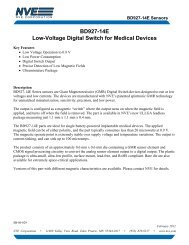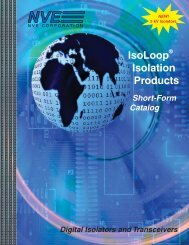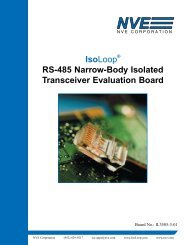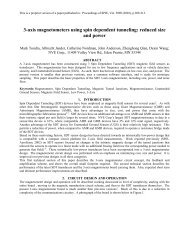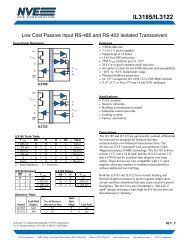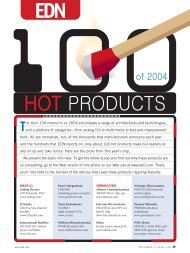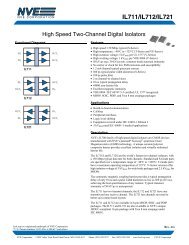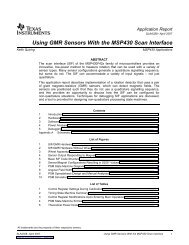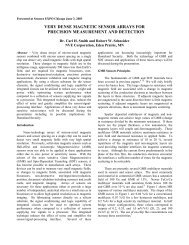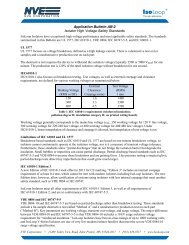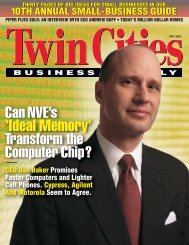Magnetoresistive Random Access Memory (MRAM) Technology (.pdf)
Magnetoresistive Random Access Memory (MRAM) Technology (.pdf)
Magnetoresistive Random Access Memory (MRAM) Technology (.pdf)
You also want an ePaper? Increase the reach of your titles
YUMPU automatically turns print PDFs into web optimized ePapers that Google loves.
<strong>Magnetoresistive</strong> <strong>Random</strong> <strong>Access</strong> <strong>Memory</strong> (<strong>MRAM</strong>)<br />
By James Daughton<br />
Copyright © 2/4/00<br />
Everitt et al, “Pseudo Spin Valve <strong>MRAM</strong> Cells with Sub-<br />
Micron Critical Dimensions”, IEEE Trans. Magn. 1998<br />
Figure 13. Sharp Bit Ends For Improving PSV Stability.<br />
The stability of the <strong>MRAM</strong> cell can be looked at as an energy well problem,<br />
where the energy associated with storage is MHcV, where Hc is a critical field<br />
which prevents magnetization reversal, M is the saturation magnetization, and V<br />
is the volume of the magnetic material in the cell. As the volume is reduced, the<br />
ratio approaches some multiple of kT (about 20) at which the error rate in the<br />
memory becomes unacceptable. Making Hc ever higher does not work because<br />
of the current required to write and the resultant heating of the cell (raising kT).<br />
With the present modes of operating, the practical lower limit to <strong>MRAM</strong> storage<br />
area would be about 0.1 micron on a side. A new idea is to use heat to help<br />
select the cell for writing and use the Curie point of an antiferromagnet to enable<br />
writing with a low current. Then at cooler temperatures, the energy well can be<br />
very deep. This is an idea that NVE is working on actively.<br />
The last challenge is getting <strong>MRAM</strong> into high production levels. It requires<br />
investment, and a lot of it, perhaps as much as a billion dollars. It will take<br />
commitment from one or more companies to manufacture <strong>MRAM</strong> in high volume,<br />
in order to realize the tremendous potential of <strong>MRAM</strong> as a mainstream<br />
nonvolatile memory technology, but with the right investment, <strong>MRAM</strong> can be a<br />
very important mainstream memory technology.<br />
References<br />
1) J. Raffel and T. Crowder, IEEE Trans. Electronic Components 13, No. 5, p. 611 (1964)<br />
2) M. Naiman, Intermag 1965, Paper 11-2.<br />
3) M. Johnson, B. Bennett, and M. Yang, “Hybrid Ferromagnetic Semiconductor Nonvolatile<br />
<strong>Memory</strong>”, IEEE Trans. Magn. 34, No. 4, pp 1054-1059 (1998).<br />
4) L. Schwee, P. Hunter, K. Restorff, and M. Shepard, “The Concept And Initial Studies Of A<br />
Crosstie <strong>Random</strong> <strong>Access</strong> <strong>Memory</strong>”, J. Appl. Phys. 53, No. 3, pp.2762-2764 (1982).<br />
5) IBM Disclosure Bulletin<br />
Contact: Jim Daughton: tel. (952) 996-1607 or email: daughton@nve.com<br />
Page 12 of 13



